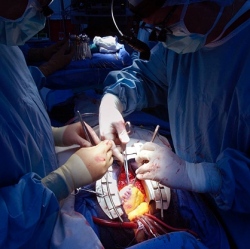
Using a custom-built four-head 3D printer and a “disappearing” ink, materials scientists created a patch of tissue containing skin cells and biological structural material interwoven with blood-vessel-like structures.
All prior regenerative tissue projects have run up against the same wall when trying to build thicker and more complex tissues: a lack of blood vessels. Lewis’s group solved the problem by creating hollow, tube-like structures within a mesh of printed cells using an “ink” that liquefies as it cools. The tissue is built by the 3-D printer in layers.
A gelatin-based ink acts as extracellular matrix, the structural mix of proteins and other biological molecules that surrounds cells in the body. Two other inks contained the gelatin material and either mouse or human skin cells. All these inks are viscous enough to maintain their structure after being laid down by the printer.
A third ink with counterintuitive behavior helped the team create the hollow tubes. This ink has a Jell-O-like consistency at room temperature, but when cooled it liquefies. The team printed tracks of this ink amongst the others. After chilling the patch of printed tissue, the researchers applied a light vacuum to remove the special ink, leaving behind empty channels within the structure. Then cells that normally line blood vessels in the body can be infused into the channels.
